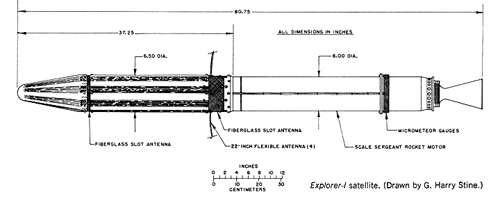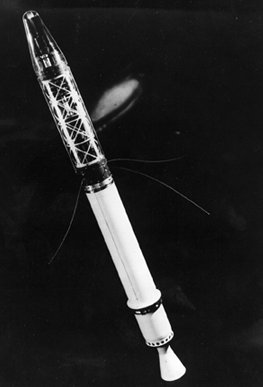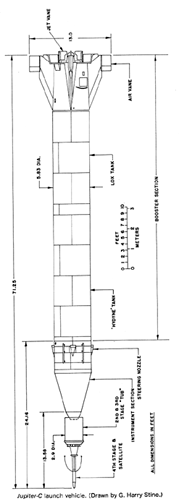The First United States Satellite and Space Launch Vehicle
Click on image to see enlarged version.

Explorer-I, officially known as Satellite 1958 Alpha, was the first United States earth satellite and was sent aloft as part of the United States program for the International Geophysical Year 1957-1958. It was designed and built by the Jet Propulsion Laboratory (JPL) of the California Institute of Technology under the direction of Dr. William H. Pickering. The satellite instrumentation of Explorer-I was designed and built by Dr. James Van Allen of the State University of Iowa.
The satellite was launched from Cape Canaveral (now Cape Kennedy) in Florida at 10:48 P.M. EST on 31 January 1958 by the Jupiter-C vehicle--a special modification of the Redstone ballistic missile--that was designed, built, and launched by the Army Ballistic Missile Agency (ABMA) under the direction of Dr. Wernher Von Braun. Jupiter-C, a direct descendant of the German A-4 (V-2) rocket, was originally developed in 1955-1956 as a high-performance rocket for testing purposes.
The Jupiter-C has its origins in the United States Army's Project Orbiter in 1954. The project was canceled in 1955, however when the decision was made to proceed with Project Vanguard.
Following the launch of the Soviet Sputnik I on 4 October 1957, ABMA was directed to proceed with the launching of a satellite using the Jupiter-C, which had already been flight-tested in nose-cone re-entry tests for the Jupiter intermediate-range ballistic missile (IRBM). Working closely together, ABMA and JPL completed the job of modifying the Jupiter-C and building the Explorer-I in 84 days.
Once in orbit, the cosmic ray equipment of Explorer-I indicated a much lower cosmic ray count than had been anticipated. Dr. Van Allen theorized that the equipment may have been saturated by very strong caused by the existence of a belt of charged particles trapped in space by the earth's magnetic field. The existence of these Van Allen Belts, discovered by Explorer-I, was confirmed by Explorer-III, which was launched by a Jupiter-C on 26 March 1958.
The discovery of the Van Allen Belts by the Explorer satellites was considered to be one of the outstanding discoveries of the International Geophysical Year.

EXPLORER-I
Characteristics
Explorer-I was placed in an orbit with a perigee of 224 miles and an apogee of 1,575 miles having a period of 114.9 minutes. Its total weight was 30.66 pounds, of which 18.35 pounds were instrumentation. The instrument section at the front end of the satellite and the empty scaled-down Sergeant fourth-stage rocket casing orbited as a single unit, spinning around its long axis at 750 revolutions per minute.
Instrumentation consisted of a cosmic-ray detection package, an internal temperature sensor, three external temperature sensors, a nose-cone temperature sensor, a micrometeorite impact microphone, and a ring of micrometeorite erosion guages. Data from these instruments were transmitted to the ground by a 60-milliwatt transmitter operating on 108.03 megacycles and a 10-milliwatt transmitter operating on 108.00 megacycles.
Transmitting antennas consisted of two fibre-glass slot antennas in the body of the satellite itself and four flexible whips forming a turnstile antenna. The rotation of the satellite about its long axis kept the flexible whips extended.
The external skin of the instrument section was painted in alternate strips of white and dark green to provide passive temperature control of the satellite. The proportions of the light and dark strips were determined by studies of shadow-sun-light intervals based on firing time, trajectory, orbit, and inclination.
Electrical power was provided by nickel-cadmium chemical batteries [sic]* that made up approximately 40 percent of the payload weight. These provided power that operated the high power transmitter for 31 days and the low-power transmitter for 105 days.
Because of the limited space available and the requirements for low weight, the Explorer-I instrumentation was designed and built with simplicity and high reliability in mind. It was completely successful.
| JUPITER-C/JUNO-I Explorer-1 Launch | ||
|---|---|---|
| Weight (in pounds) | ||
| Loaded | Empty | |
| Overall (takeoff) | 64,000 | 10,260 |
| Stage 1 | 62,700 | 9,600 |
| Stage 2 | 1,020 | 490 |
| Stage 3 | 280 | 140 |
| Stage 1 | 80 | 31.5 |
Propulsion
Stage 1: Rocketdyne A-7 engine.--
Thrust, 83,000 lb;
burning time, 155 seconds; specific impulse, 235 seconds;
propellants, liquid oxygen, as oxidizer, and "Hydyne" (60% unsymmetrical,
dimethylhydrazine and 40% diethylenetriamine), as fuel; propellant feed,
turbopump type; turbopump drive, 90% hydrogen peroxide decomposed by
catalyst bed to produce steam.
Stage 2: Eleven JPL scaled-down Sergeant rockets.--
Thrust,
16,500 lb; burning time, 6.5 seconds; specific impulse, 220
lb-sec/lb; propellant, polysulfide-aluminum and ammonium perchlorate
(solid propellant).
Stage 3: Three JPL scaled-down Sergeant rockets.--
Thrust,
5,400 lb; burning time, 6.5 seconds; specific impulse, 235
lb-sec/lb; propellant, same as for Stage 2.
Stage 4: One JPL scaled-down Sergeant rocket.--
Thrust,
5,400 lb; burning time, 6.5 seconds; specific impulse, 235
lb-sec/lb; propellant, same as for Stage 2.
Flight History
JUPITER-C (three-stage configuration):
20 September 1956: Lofted an 86.5-pound payload to an altitude of 680 miles and a range of 3,300 miles from Cape Canaveral, Florida.
15 May 1957: Lofted an 300-pound scale Jupiter ablative nose cone to an altitude of 350 miles and a range of 710 miles.
8 August 1957: Lofted a 1/3-scale Jupiter nose cone to an altitude of 285 miles and a range of 1,330 miles. JUNO-I (four-stage configuration).
31 January 1958: Orbited Explorer-I satellite weighing 30.66 pounds with 18.35 pounds of payload, perigee 224 miles, apogee 1,575 miles. Still in orbit (1965).
5 March 1958: Attempted orbit of Explorer-II (31.36 pounds with 18.83 pounds of payload) failed because fourth stage did nt ignite.
26 March 1958: Orbited Explorer-III satellite weighing 31.0 pounds with 18.53 pounds of payload, perigee 119 miles, apogee 1,740 miles. Down 28 June 1958.
26 July 1958: Orbited Explorer-IV satellite weighing 37.16 pounds with 25.76 pounds of payload, perigee 163 miles, apogee 1,373 miles. Down 23 October 1959.
24 August 1958: Attempted orbit of Explorer-V satellite (37.16 pounds with 25.76 pounds of payload) failed because booster collided with second stage after separation, causing upper stage firing angle to be off.
23 October 1958: Attempted orbit of 12-foot inflatable Beacon satellite (31.5 pounds with 18.3 pounds of payload) failed when second stage separated prematurely from booster.
*These were not nickel cadmium batteries but were Mallory type RM mercury cells.
See: Ludwig, George H. "Cosmic- Ray Instrumentation in the First U.S. Earth Satellite" The Review of Scientific Instruments, Volume 30, Number 4, April 1959.
See also: Space Activities Summary, S-58-1, prepared by Office of Public Information, U.S. National Aeronautics and Space Administration, December 1960.

